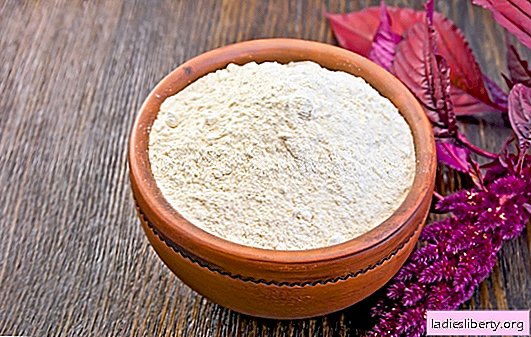
Flour can be not only wheat - it is known to everyone, but not everyone knows its exotic amaranth variety. But if she appears in the kitchen, the appetite of familiar dishes will appear in a new way and there will be reason to be proud of herself for choosing a product that is exclusively beneficial for health and even a slim figure.
How are the composition and benefits of amaranth flour interconnected and in what cases should it be included in the diet
Amaranth is one of the oldest crops (originating from South America), but also in its eponymous genus, some herbaceous plants are known as weeds, others as decorations of parks.
Edible amaranth grains are partly consumed as cereal, and partly ground into flour.
The energy value of amaranth flour is about 300 kcal per 100 g, which is comparable with the figures for wheat, oat, and rice flour.
One of the main advantages of amaranth flour is the almost complete absence of gluten in it, which makes it a suitable product for intolerance to this substance (gluten). However, gluten-free diets are not always adhered to because this is the diagnosis - even in the opinion of a number of nutritionists and fitness trainers, it contributes to weight loss.
Amaranth flour is rich in protein, including essential amino acids, for example, lysine, the presence of which in large quantities in plant products is, in principle, rare. And this element is very necessary for:
· Cell renewal;
· Production of enzymes;
· Maintaining a normal level of serotonin (which is necessary for a good mood);
· Restoration of depleted body forces (for example, after an illness)
If we compare amaranth with wheat, then it will be several times superior to it in terms of iron content, and in terms of calcium content, amaranth outperforms even whole cow’s milk, more than twice as much.
Amaranth flour is also saturated with other minerals - manganese, selenium, phosphorus, zinc, magnesium, potassium, copper, as well as vitamins - C, B2, PP, A, B1, E, B4, D.
This product, partly due to vitamin E and a high fiber content, has a positive effect on the state of the gastrointestinal tract, contributing to:
· Regeneration of damaged by diseases or malnutrition of the mucous membranes;
· Normalization of acidity of gastric juice;
· Acceleration (if it is slowed down) of intestinal motility;
· Preventing a disease such as colitis.
Amaranth flour is a supplier of antioxidants, the deficiency of which in the conditions of modern ecology and lifestyle of many people leads to disruptions in the functioning of the body in virtually all areas (from external signs of aging to destabilization of the nervous system, heart disease and a high risk of cancer).
Also, the regular use of amaranth flour has a positive effect on the following:
· Prevention of liver obesity;
· Improved joint mobility (by supporting collagen synthesis);
· Increased physical stamina.
Features of the benefits of amaranth flour for diets and a healthy lifestyle
Every dish made of amaranth flour quickly and well saturates, so nutritionists recommend including it in lightweight menus - it’s worth adding a little product, for example, to a sauce of stewed vegetables or soup puree - and now you are not threatened by stress that disturbs unmet appetite.
Some unique substances in the composition of amaranth unusually affect metabolic processes, contributing to the accelerated burning of fat reserves in the body.
In addition, the processes of blood circulation and cellular respiration normally occur in the epidermis, and the retention of collagen and elastin is activated.
All this and something else leads to the fact that after weight loss the skin does not sag and quickly comes in tone, and yet - you can look a little younger than his age.
The use of amaranth flour helps to improve blood renewal and remove "bad" cholesterol from it, and to cleanse the body of toxic elements and waste.
And nutritionists are unanimous in the opinion that the timely release of the body from non-useful substances is one of the priority tasks for a healthy lifestyle.
How to choose, store and use amaranth flour with benefit
Amaranth flour of good quality should be friable and uniform, a shade from grayish-yellow to pale caramel.
The highest quality product is sold in paper packaging - the one in plastic, with a high degree of probability, can go rancid, even when fresh, because this material is not breathable.
At home, for even better preservation, it is recommended to pour the flour into a glass jar with a tight-fitting lid and put it in a dry, dark place.
Amaranth flour is used quite widely in world cuisine. It is added to soups, casseroles, desserts and drinks (e.g. milkshakes).
Baking with amaranth flour (bread, pancakes, cookies, muffins) turns out to be lush, stored for a long time, not stale and has a delicate nutty flavor and aroma.
And here the absence of gluten (gluten) cannot be considered a plus of amaranth flour - to bake something, it is very desirable to mix it with other types of flour, for example, wheat. But it is combined (to taste) also with corn, oat and rice.
Amaranth flour is also suitable for dumplings and pasta.
This exotic product is also used for thickening sauces and gravy, breading cutlets, improving the consistency of various fillings and minced meat for meatballs, it can be added to a side dish (for example, in vegetable puree), milk porridge and homemade yogurt.
The advantage of the product can rightly be called the fact that neither time (morning, day, evening), nor compatibility with other products do not affect its digestibility - it is always digested easily and quickly.
In order to fully benefit from amaranth flour, nutritionists recommend using it 2-3 days a week, adhering to a daily norm of up to 150-200 g for an adult.
What is the harm of amaranth flour
First of all, it must be said that amaranth flour can be consumed only after heat treatment, if it is planned to add it to some dish without cooking (for example, a protein shake), then the flour in its pure form must be pre-roasted for 10 minutes in the oven at a temperature of 110 ° C.
This is explained by the fact that raw amaranth grains contain a certain amount of oxalates and nitrates, which can negatively affect the functioning of the body (in particular, interfering with the absorption of nutrients from food and drinks).
And after exposure to high temperatures in amaranth flour there is not a drop of harm - the toxic properties of these elements are neutralized.
But in principle, do not get too carried away with it, since a strong excess of the recommended daily intake is fraught with such unpleasant consequences as nausea, heartburn and diarrhea.
Nutritionists recommend abandoning amaranth flour while taking medications, the action of which is aimed at normalizing high blood pressure and lowering blood glucose levels, since this product has a similar effect on a person and, therefore, there may be too many effects multiplied by two.
In order to avoid harm from amaranth flour, that is, a deterioration in the health of certain areas of health, this product is undesirable in the diet for diseases of the kidneys and gall bladder, since amaranth grains are high in oxalic acid.
Finally, in rare cases, an allergic reaction manifests itself on amaranth flour.











